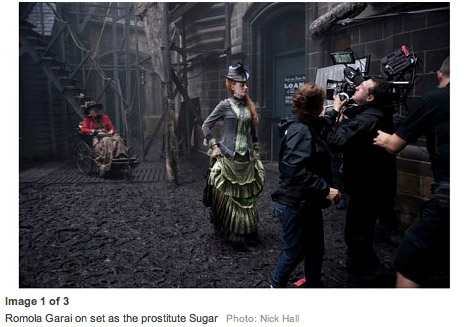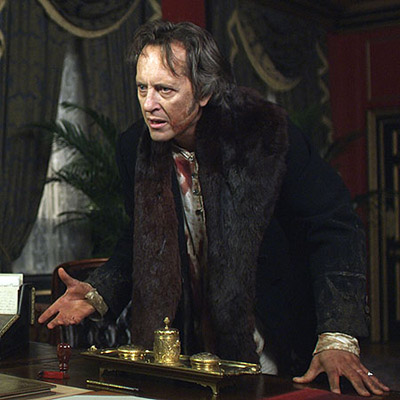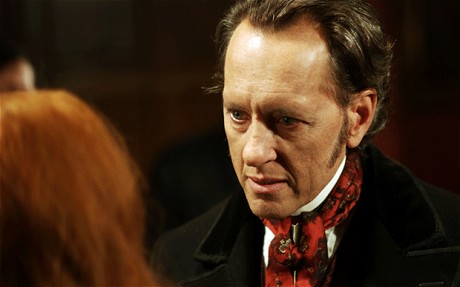March7
The Telegraph – March 7th, 2011.
By Sally Williams

London, 1870s: I’m sitting in the Fireside Tavern with a bunch of Victorian prostitutes. You can tell that they are prostitutes because they have got too much bosom bulging from too-tight bodices; too much hair spilling from pinned-up locks; and too much face powder on over-bright cheeks. It is a haze of taffeta and cleavage that has been recreated from snapshots of Victorian whores. Romola Garai is about to make her big entrance.
These prostitutes are extras from BBC Two’s The Crimson Petal and the White, the forthcoming big-name four-hour mini-series featuring Garai, Gillian Anderson, Richard E Grant and Chris O’Dowd. Directed by Marc Munden, and adapted from Michel Faber’s book of the same name, it charts the relationship between Sugar (Garai), a superior prostitute, and William Rackham (O’Dowd), a perfume magnate.
Faber’s novel is a vivid Dickensian epic about lust, outsiders, class and power. It is also a brilliant work of historical accuracy. His world is furnished with extraordinary detail of the sweat, noise, filth and colour of Victorian London. He even exposed uncomfortable truths, such as the fact that the powder the prostitutes douched themselves with as a post-sex contraceptive was a horrific toxic mix. ‘Michel Faber has produced the novel that Dickens might have written had he been allowed to speak freely,’ one reviewer wrote.
In 2007, five years after Faber’s book was published, David Thompson, the former head of BBC Films and the founder of Origin Pictures, an independent film and television production company, read a copy on holiday. He was gripped by the story of how Sugar, 19, escapes her brothel to become Rackham’s mistress – and subsequently the governess for his daughter, Sophie. ‘I was completely obsessed with it, completely fell in love with it,’ he says. ‘It shows you Victorian London in a way you have never seen before, but most of all it’s a really ripping emotional yarn with incredible characters.’
These include Mrs Castaway (Anderson), vicious and vinegar-thin, who is Sugar’s madam and also, it transpires, her mother. Sugar was 13 when her mother first tiptoed to her bed to tell her there was a gentleman come to keep her warm. The novel’s ‘hero’, Rackham, who is married to Agnes (Amanda Hale) but blooms under Sugar, metamorphosing into a man of business, churning out mid-market face creams, certainly lacks moral principles, but is not quite an out-and-out villain. Agnes is a delicate child-bride, sent close to the edge by fear of her monthly periods and the internal probings of creepy Dr Curlew (Grant).
And then there is Sugar, pin-thin with a congenital skin condition, a kind of goddess among whores (you can do things to her that others won’t allow). She puts men at her mercy with a unique combination of sexual debasement and a bountiful brain.
Thompson returned from holiday and straight away tried to secure the rights, but found they were tied up with a big international film company. ‘By good luck for us, they didn’t pursue it and they let the option go,’ he says. Origin bought the rights in 2008. The big question was how to film it. Here is an 800-page novel; a sumptuous meal of prose; a film true to the content would last for days.
Thompson approached Lucinda Coxon, a playwright and screenwriter best known for Happy Now?, which played at the National Theatre in 2008. They had worked together on The Heart of Me, a film adaptation of Rosamond Lehmann’s novel. And Coxon knew all about Crimson Petal as she had been approached for the film adaptation.
‘That didn’t work out and when I reread Crimson Petal I was astonished by it. I had a much bigger emotional response. It’s partly that one grows up a bit, but probably the main thing that had happened to me in the meantime was that my daughter had got much older. When I first read the book she was a baby, and suddenly the last third of the book, where Sugar is involved with Rackham’s daughter, made so much more sense to me.’
The result is that Coxon has made parenting the prism. ‘I think it’s a story full of people looking for mothers,’ she says. Sugar is damaged by her mother, and so is Rackham (his ran away); Sophie is neglected – we don’t even discover Rackham has a child until about halfway through the novel; and Mrs Emmeline Fox, Dr Curlew’s daughter, who volunteers for the Rescue Society, a charity that helps to reform prostitutes, becomes a sort of a mother to the fallen women.
But what about the sex? Crimson is a huge story; a great read. But it’s so filthy. Faber never resorts to softcore euphemisms such as ‘manhood’ or ‘member’. ‘Sex is hardcore,’ Faber commented in an interview. ‘It should be hardcore. I can’t see the point of having a pink-tinged, fluffy version of sex.’
Won’t nice, wholesome BBC Two viewers be horrified? ‘When I had that conversation early on with the BBC, they said, “Oh, don’t worry about that,” ‘ Coxon recalls. ‘When you’re looking at a book that big, and one so full of complications, the last thing you worry about is whether or not you can see an erect penis.’
Ben Stephenson, the controller of BBC drama commissioning, emphasises the point. ‘We want Crimson to be sexy and dark and driven by psychology. Period drama like you’ve never seen it before.’
Coxon is not as explicitly carnal as the novel, nor as vile (there is one very disturbing scene in the novel involving Rackham and ‘twin’ girls). But Sugar and Rackham do work through a varied menu, and the sex is mostly hoggish with lots of close-ups on Sugar’s eyes. The point is to show that she is calculating how to get the most of her latest victim.
‘I didn’t want it to become prurient,’ Coxon says. ‘ “Oh, the awful things these prostitutes suffer. Come and have a look at one of them now! Oh, it’s disgusting!” ‘ Sugar, she says, is not as compliant as her clients would like to believe. ‘There’s an exciting tension between her brain and her abasement, and that’s partly because she has engineered that. She is manipulating other people so they can force her into something that she has already anticipated.’
Back at the Fireside, which is in fact Wilton’s, a Victorian music hall in east London (‘We’re not in Cranford land,’ Grant Montgomery, the production designer, says. ‘St Giles, the area where Sugar lived, was a kind of Devil’s Acre – the police wouldn’t go there unless they were armed’), I’m struck by some of the details of the prostitutes’ outfits. There are pink spangly socks from Primark; high-heeled lace-up brogues from Matalan; and one of the prostitutes looks more like a wayward schoolgirl: all large gold hoop earrings and fingerless lace gloves.
‘We wanted to get away from television period genre tropes: things we’ve seen before,’ Steve Lightfoot, the producer, says. Consequently, all period-costume clichés have been banned. The prostitutes wear bruised colours: purples, yellows, greens, blues. ‘Nothing jolly, pretty or decorative,’ Annie Symons, the costume designer, points out. She has flouted history by adding a ferret-fur stole here, a feather hair clip there. Sugar’s ‘arch whore’ dress is trimmed with fake human hair from Shepherd’s Bush market. ‘I just wanted to feed into the corporeality,’ Symons explains. ‘Make it quite animal and sexual.’ Her chief inspirations were Alexander McQueen, Max Ernst, A Clockwork Orange and Gangs of New York, not historical sources in museum archives.
This is a key scene where Rackham and Sugar first meet. He has read about Sugar in More Sprees in London, a publication for the man about town which surveys ‘hocks’ (cheapest brothels) and ‘prime rump’. Their meeting over a drink is a pre-coital warm up. But rather than a quick cut to stockings lying on the boudoir floor, Rackham gets a talk about Ruskin, and then more talk about Tennyson.
There’s a blast of cold air as the door swings open and Romola Garai walks in. She looks extraordinary. Her pale porcelain skin is set off by a slate-grey dress; her long, long limbs and high-crowned hat elongate her so her 5ft 9in looks about 6ft 3in. Her back is straight, her head held high and her lips are cracked with a special paste that she says is amazing because you can flake it off on camera to make it look like real eczema. The whole effect – the red hair, the height, the fair eyelashes, the flaking lips – is ethereal and other-worldly, and of course makes all the other prostitutes look like squat toads.
‘I wanted her to stand out,’ Jacqueline Fowler, the make-up designer, says. ‘I didn’t want anybody else to be red-headed. I broke a lot of rules in what you would do [with a leading lady]. All the little flaws that people have, I actually wanted to play on – like not tinting any eyelashes, and I didn’t want to have any blusher or red lipstick.’
Garai’s performance is electric. One minute she’s flinty, cold-eyed and dangerous; the next she looks ravishing, cheeks flushed and red curls swirling around her face. You really believe she is capable of calculation.
‘We did audition a lot of actresses, but she’s got a very great mastery of the complexity of the part,’ Thompson says. ‘She brings a lot of nuance, a lot of subtlety, a great intelligence and she is also very beautiful. It’s very hard to find one actor with a combination of all these things.’
When I meet Garai she explains that she has played lots of period heroines (As You Like It, Atonement, Emma) and is loving this because it is so different. ‘Normally with costume dramas everyone is going, “Oooh, it looks so beautiful.” And they get married in the end. This is not like that at all.’
Crimson requires her to go topless, have sex in compromising positions and squat over a bowl. Did she struggle with that? ‘Well, on the one hand you have all this guff about it being a strong, amazing part, but if your tits are out for 25 minutes at the beginning, you think, how do you play it? But Lucinda’s attitude to the sex is something I felt very comfortable with. She makes it very clear in her script that Sugar is not racked with ecstasy. It’s a job and she’s very good at it, but it’s as a result of child abuse and let’s not be coy about that.’
Chris O’Dowd is an enticing prospect because he is best-known for the comedy The IT Crowd. O’Dowd’s face isn’t Byronic but luscious and squashy. ‘There are nice moments of humour and I’ll probably play those a little stronger than maybe another actor,’ he says. He also fulfils the filmmakers’ drive for freshness, although he reminds me that he has been in period drama before, including Gulliver’s Travels.
‘You don’t want the same old faces, and Chris has a refreshing openness to him,’ Lightfoot says. ‘We’re trying to make it a little more modern, a little more odd, a little more dangerous.’
These are dark waters, and Richard E Grant wastes no time in muddying them further as the sinister Dr Curlew. ‘I’ve been given pointy shoes and pointy sideburns,’ he says when I ask him how he highlights his character’s creepiness. Grant’s last period drama was Gosford Park, where he had a wildly different experience playing an under-footman called George, who resented the stuffed shirts upstairs and bonked every parlour maid he could.
‘Everything is sex in my experience,’ he says. ‘It’s about the wanting of it, or the longing for it, or the not having it or the unrequited nature of it – it’s all that, and Dr Curlew doesn’t get anything, so all that energy has to go into something else.’ He goes on, ‘Marc [Munden] has insisted that it is played very quietly and is not in any way histrionic. Just somebody who is very focused on getting what he wants.’
This is the chord that Munden likes to strike. ‘He’s incredibly bold and modern and has got a real desire to be different,’ Lightfoot says. Best-known as the director of the mini-series The Devil’s Whore (2008), Munden started out as an assistant for Mike Leigh, Derek Jarman and Terence Davies. His style is artful. There are no long, languorous shots of landscape. The camera never stops. It cuts in tight on the actors; plays with focus and angles. The action unfolds in disjointed sequences designed to take you into the psyche of the character. You feel him probing ahead, twisting and turning in a dozen directions.
So what will Faber make of it? ‘I don’t think that anyone could reasonably claim that The Crimson Petal is one of those guided tours of a tourist 19th century, where you go to look at all the pretty costumes,’ he observed of his novel soon after it was published. This four-part series may not make historical sense, but in its aim to shake the good manners of costume drama, it does Faber proud.
‘The Crimson Petal and the White’ starts on BBC Two on March 16
 The REG Temple is the official website for actor, author and director Richard E. Grant.
The REG Temple is the official website for actor, author and director Richard E. Grant.








